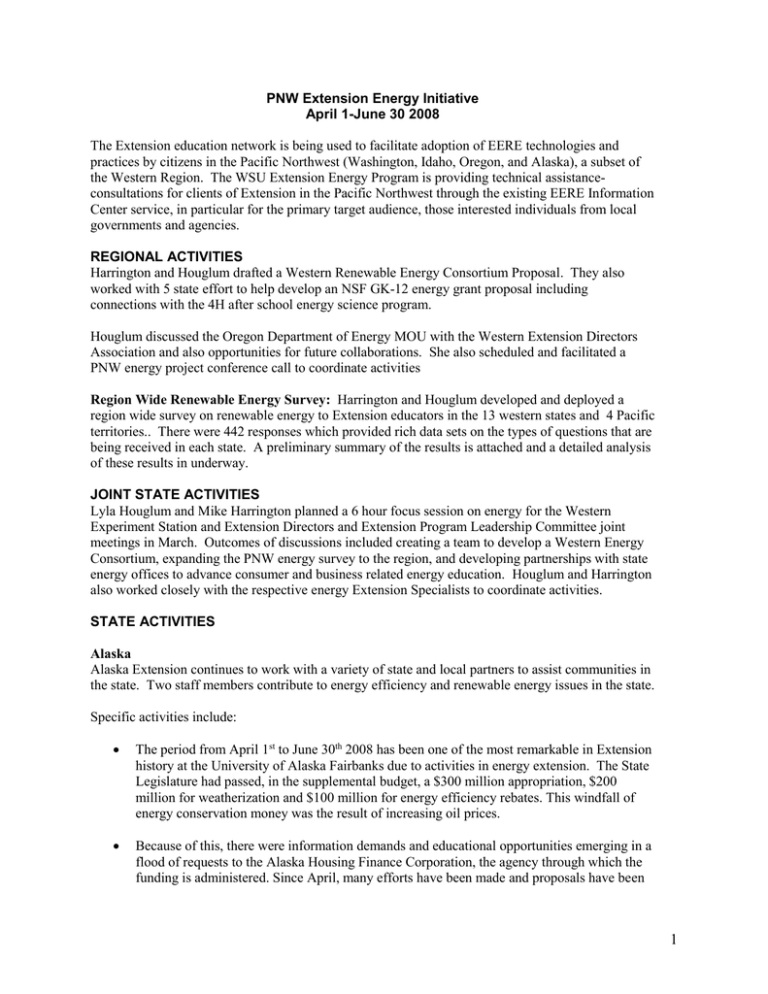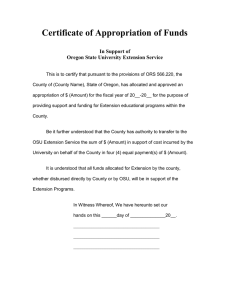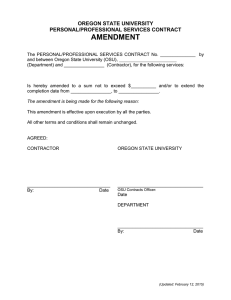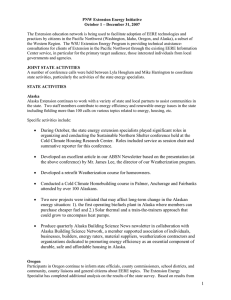April-June 2008
advertisement

PNW Extension Energy Initiative April 1-June 30 2008 The Extension education network is being used to facilitate adoption of EERE technologies and practices by citizens in the Pacific Northwest (Washington, Idaho, Oregon, and Alaska), a subset of the Western Region. The WSU Extension Energy Program is providing technical assistanceconsultations for clients of Extension in the Pacific Northwest through the existing EERE Information Center service, in particular for the primary target audience, those interested individuals from local governments and agencies. REGIONAL ACTIVITIES Harrington and Houglum drafted a Western Renewable Energy Consortium Proposal. They also worked with 5 state effort to help develop an NSF GK-12 energy grant proposal including connections with the 4H after school energy science program. Houglum discussed the Oregon Department of Energy MOU with the Western Extension Directors Association and also opportunities for future collaborations. She also scheduled and facilitated a PNW energy project conference call to coordinate activities Region Wide Renewable Energy Survey: Harrington and Houglum developed and deployed a region wide survey on renewable energy to Extension educators in the 13 western states and 4 Pacific territories.. There were 442 responses which provided rich data sets on the types of questions that are being received in each state. A preliminary summary of the results is attached and a detailed analysis of these results in underway. JOINT STATE ACTIVITIES Lyla Houglum and Mike Harrington planned a 6 hour focus session on energy for the Western Experiment Station and Extension Directors and Extension Program Leadership Committee joint meetings in March. Outcomes of discussions included creating a team to develop a Western Energy Consortium, expanding the PNW energy survey to the region, and developing partnerships with state energy offices to advance consumer and business related energy education. Houglum and Harrington also worked closely with the respective energy Extension Specialists to coordinate activities. STATE ACTIVITIES Alaska Alaska Extension continues to work with a variety of state and local partners to assist communities in the state. Two staff members contribute to energy efficiency and renewable energy issues in the state. Specific activities include: The period from April 1st to June 30th 2008 has been one of the most remarkable in Extension history at the University of Alaska Fairbanks due to activities in energy extension. The State Legislature had passed, in the supplemental budget, a $300 million appropriation, $200 million for weatherization and $100 million for energy efficiency rebates. This windfall of energy conservation money was the result of increasing oil prices. Because of this, there were information demands and educational opportunities emerging in a flood of requests to the Alaska Housing Finance Corporation, the agency through which the funding is administered. Since April, many efforts have been made and proposals have been 1 submitted which will increase our teaching workload. This response was necessary to meet the increasing demand for energy outreach information programs and teaching opportunities. We have updated information on the Alaska Energy PORTAL to proved interested folks with information on the new state programs. The intent of this service is to address public information needs for how to qualify, who can qualify, and where to apply for weatherization. Another need is to increase the number of contractors doing energy efficiency audits (energy ratings), which are crucial to the beginning and end point determinations for the energy efficient rebate program. We have initiated weatherization education programs under contract to Interior Weatherization in Fairbanks, and have collaborated with the Cold Climate Housing Research Center at the University in Fairbanks to deliver several levels of energy efficient retrofit training and education courses and techniques-based courses, for meeting the public demand for this education. We have also proposed through the Alaska Housing Finance Corporation to use the Extension network in a model arrangement to allow our agents professional development training in order to serve as a “first point of contact” for this energy efficient weatherization and retrofit information. This will provide one month of funding for each Extension agent in the Health, Home and Family Development Program as well as a training session, taught by Rich Seifert, to be funded and in operation over the next year. Oregon Participants in Oregon continue to inform state officials, county commissioners, school districts, and community, county liaisons and general citizens about EERE topics. The OR Energy Extension Specialist has continued to refine the farm energy assessment model patterned after the OSU Industrial Assessment Center model. An agreement has been reached to test the model by assessing four OSU facilities including: the OSU Dairy, the OSU Greenhouse, the OSU Vegetable Farm, and the Hyslop Farm (Horticulture). Student time will be paid for by OSU. This effort will create an opportunity to start building a body of knowledge on likely energy efficiency improvement opportunities in the agricultural sector. Discussions are on going with the Oregon Department of Agriculture on the possibility of expanding the pilot assessment to private entities outside of the OSU facilities. The model contains the following factors: General: * Refrigeration efficiency (walk in coolers etc) * Irrigation efficiency (including moisture sensing to avoid over irrigation) * Fuel efficiency on farm vehicles * GPS control on tractor operation (fof fuel, seed and soil amendment conservation) Dairy Farm * Refrigeration for bulk tanks * Vacuum pumps * Efficient manure pumping Nursery Greenhouse efficiency 2 * Efficient boiler * Improved greenhouse material (better light transmission) * Thermal blankets (at night) * Improved air seals * Sealing off idle sections of greenhouse Poultry Farms * Efficient heaters * Efficient lighting An example to specific activities within a particular county is shown by the efforts that OSU Crook County Extension Service has made toward Renewable and Alternative Energy within Crook County and the community of Prineville, OR. Crook County Extension has been involved in several different projects ranging from biodiesel on the farm, to biomass to heat projects. The following is an overview that will give specifics and generalities of the work performed through the outreach and education efforts of renewable energy. Woody-biomass Heat Workshop – Bend o May 2008 (90 miles, 12 hours) The workshop discussed anything from new biomassto-heat technologies to possible funding opportunities Wind Energy Meeting – Pendleton o May 2008 (400 miles, 12 hours) Energy Trust of Oregon sponsored the event and discussed the potential for small wind energy generation for on-farm applications Alternative Diesel Site Visit – Pasco, WA o May 2008 (500 miles, 12 hours) Visited the Pilot Plant of Privately owned company who is on the verge of producing alternative diesel fuel from several various feedstocks Woody-biomass Grant – For Woodgrain o Fall 2007 – present (No travel, 60 hours) Continuous work with OSU Industrial Assessment to help finish the Assessment for Woodgrain Millworks Idaho The Extension specialist (jointly employed by Idaho and Washington) continued to provide follow up and answers to respondents to the earlier state EERE Survey and with other interested Extension staff; developed presentations of biofuels and renewable energy for an ID Extension Annual Conference in April. Other activities included developing an informational website for a school district and providing organization and information for biofuels field days. Washington: The WSU Energy Extension Program continues to provide information via the web including a weekly electronic newsletter “Energy Newsbriefs” which is sent to the participating states. Specific Activities: The Energy center provided responses to 22 cases requesting information and additional consultation. 3 The Extension specialist (jointly employed by Idaho and Washington) continued to provide information on alternative and renewable energy workshops and energy meetings MATCHING CONTRIBUTIONS AK ID OR WA (includes Energy Center) H. M. Harrington Total 4,182.30 6,469.92 29,934.13 13,114.39 1000.00 $54,700.74 4 Western Region Extension Energy Survey Preliminary Summary Background: The PNW states received a U.S. Department of Energy grant facilitate energy education and extension in Alaska, Idaho, Oregon, and Washington. As part of this effort a regional survey was conducted to help identify the kinds of energy-related inquiries that are coming to Extension offices, the energy-related work that Extension is involved in, and the resources available. Results: An invitation to respond to the on-line survey was sent to Extension offices throughout the region. There were 443 responses, coming from all 13 states (AK, AZ, CA, CO, HI, ID, MT, NV, NM, OR, UT, WA, WY) as well as from Guam, Micronesia, and Northern Marianas. A full summary of survey questions and results is available, and some states are analyzing results specific to their state. A more succinct summary follows. Not all respondents responded to each question; therefore, percentages are based on the total number of replies to each question. A majority of respondents assessed the level of public interest in both renewable energy and energy efficiency as very high or high. Renewable Energy: 60% (very high 22%; high 38%) Efficiency/Conservation: 61% (very high 23%; high 38%) Very few respondents said that any entity in their community provides “a great deal” of energyrelated assistance. Entities giving “some” or “very little” assistance were: Cooperative Extension Service (37% some; 35% very little) State Government (34% some; 32% very little) Colleges and/or Universities (27% some; 33% very little) Citizen-level organizations, such as Co-ops or non-profits (29% some; 32% very little) Federal Government (23% some; 37% very little) Local/County/Borough Government (22% some; 37% very little) Citizens themselves (25% some; 34% very little) Industry (29% some; 26% very little) Respondents reported that the most frequent topics of energy-related information requests they received in the last year (at least one per month, and up to several per week) were: 39% — Bioenergy/Biofuels/Biomass 29% — Climate Change 27% — Energy efficiency/conservation on the farm/ranch 24% — Energy costs and comparisons 23% — Energy efficiency/conservation in their homes 21% — Wind energy 19% — Energy efficiency/conservation in transportation technology 19% — Solar photovoltaics Fewer requests (in this order of frequency) were on these topic choices: solar thermal, energy efficiency/conservation in commercial buildings, geothermal, fuel cells, wave energy, micro hydro. 5 The most frequent responses to “How have you responded to energy related requests for information and education programs?” were: o Referred to other agencies/organizations o Located and distributed information to clientele 52% of respondents indicated that an expanded role from an Extension Energy outreach program would be of help in their work (through easier referrals, support, etc.). Energy-related resources to which respondents indicated they were “very interested” in having access were: 43% — Informational web sites 40% — Phone numbers and referral information for clientele use 37% — Brochures or other educational materials 30% — Community/area energy needs assessment 25% — In-service training/workshops 25% — Power point slides and presentations Energy-related resources that respondents had “used or referred someone to” within the past year (or were “aware of”) were: 41% used WSU Energy Program Clearinghouse (59% aware) 41% used Western Area Power Administration Energy Services (59% aware) 39% used Western Interstate Energy Board Resources (61% aware) 36% used USGS Western Energy Resources Program (64% aware) 35% used U.S. Department of Energy Best Practices website (65% aware) 32% used Western Energy Institute (68% aware) 31% used Northwest Energy Efficiency Alliance (69% aware) The open-ended request “If you are interested in being involved in energy related Extension work please provide your name, phone number and email address” elicited more than 100 responses. Several comments pointed to a need for energy expertise in Extension: o “…Since we fired all of our energy extension faculty when the fed funds went away…we have lost our brand awareness for this work. …Extension must either hire about 5 new faculty in each state, and/or provide salary bonuses for extension faculty currently working in traditional areas … to incorporate energy education into our existing program plans. For example, an Aggie would receive training on energy efficient approaches for farm systems.” o “We used to have an Energy agent. When the grants ran out and there was no money he was let go.” o “I would love to do more with energy, but I do not personally have the time in my FTE for it. It’s a big need in poverty communities, and a big priority of the tribal government we serve.” 6


